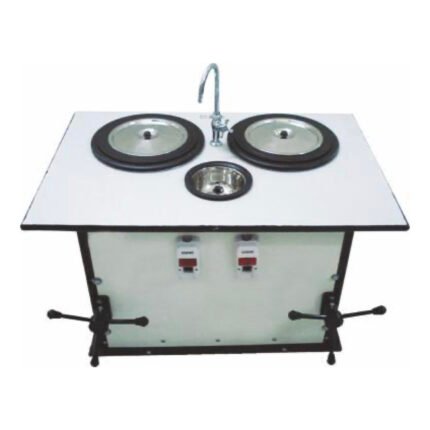AZA 1014 FATIGUE TESTING MACHINE
- AZA 1014 Fatigue Testing Machine: Evaluates material resistance to cyclic loading.
- Predicts component service life and prevents fatigue failures.
- Features precise cyclic load application and high-frequency operation.
- Advanced digital control and comprehensive data analysis software.
- Complies with international standards like ASTM E466 and ISO 1143.
- Essential for R&D, quality control, and failure analysis in various industries.
- Robust construction ensures reliable and repeatable fatigue test results.
- Available with various load capacities and test modes (axial, bending, torsion).
Description
AZA 1014 Fatigue Testing Machine: Ensuring Component Durability Under Cyclic Stress by Azalab
The Azalab AZA 1014 Fatigue Testing Machine is a highly specialized and critical instrument designed to evaluate the resistance of materials and components to failure under repeated or cyclic loading. Unlike static tensile or compression tests that measure properties under a single, continuously increasing load, fatigue testing simulates the stresses that materials experience during their operational lifetime. Fatigue failure, which occurs under stresses far below a material’s static yield strength, is a leading cause of catastrophic failures in engineered components. The AZA 1014 plays a vital role in predicting the service life of materials, understanding their endurance limits, and preventing premature component failure, making it indispensable for R&D, quality control, and failure analysis in various industries across India and globally.
Understanding Fatigue and Its Measurement with the AZA 1014 Fatigue Testing Machine
Fatigue is a process of progressive, localized, and permanent structural change that occurs in a material subjected to fluctuating stresses and strains. This change may culminate in cracks or complete fracture after a sufficient number of fluctuations. The AZA 1014 Fatigue Testing Machine is engineered to precisely replicate these cyclic loading conditions. The typical process involves:
- Specimen Preparation: A precisely machined specimen is prepared from the material under investigation.
- Mounting: The specimen is securely mounted in the machine’s grips or fixtures.
- Cyclic Loading: An actuator applies repetitive loads (e.g., tension-compression, bending, or torsion) to the specimen at a controlled frequency, amplitude, and mean load.
- Monitoring: The machine continuously monitors the applied load, displacement, and the number of cycles.
- Failure Detection: The test continues until the specimen fractures or reaches a predetermined number of cycles (run-out). The data obtained from such tests are typically plotted as S-N curves (Stress vs. Number of cycles to failure), which illustrate the relationship between the applied stress amplitude and the number of cycles a material can endure before failure. These curves help determine the material’s fatigue limit or endurance limit, which is the stress level below which the material can theoretically withstand an infinite number of cycles without failing.
Key Features of the AZA 1014 Fatigue Testing Machine for Reliable Results: The Azalab AZA 1014 Fatigue Testing Machine is designed for accuracy, versatility, and ease of use in performing critical fatigue evaluations:
- Robust Load Frame: Features a high-stiffness, stable load frame capable of handling dynamic cyclic loads without unwanted vibrations or deflections.
- Precision Actuator: Utilizes a highly responsive actuator (e.g., electromechanical or servo-hydraulic, depending on required force and frequency) for precise application of cyclic loads in various modes (tension, compression, bending, or combined).
- High-Accuracy Load Cell & Sensor: Equipped with a high-resolution load cell for accurate force measurement and a displacement sensor for precise control of strain or displacement amplitude.
- Advanced Digital Control System: Features a state-of-the-art digital controller, often PC-based, enabling sophisticated test profile programming (e.g., sine, square, triangle, custom waveforms), closed-loop control (load, displacement, or strain control), and real-time data acquisition.
- Variable Frequency Operation: Capable of operating across a wide range of frequencies (e.g., 1 Hz to hundreds of Hz or more), allowing simulation of various operational speeds.
- Automatic Cycle Counter & Failure Detection: Built-in high-speed cycle counter and automatic failure detection mechanisms (e.g., sudden load drop, specimen separation) for reliable test termination.
- Comprehensive Software: User-friendly software for test setup, real-time data plotting (e.g., stress-strain hysteresis loops), fatigue life calculation, S-N curve generation, statistical analysis, and customized report generation.
- Versatile Grips & Fixtures: Accommodates a range of specimen geometries with interchangeable grips and fixtures for different test types (e.g., axial, rotating bending, cantilever bending).
- Safety Interlocks: Equipped with essential safety features like emergency stop buttons, over-travel limits, and overload protection to ensure operator and machine safety.
Diverse Applications and Standards Compliance: The AZA 1014 Fatigue Testing Machine is crucial across many high-stakes engineering sectors:
- Automotive & Aerospace: Testing engine components, airframe structures, suspension parts, and fasteners.
- Power Generation: Evaluating turbine blades, pressure vessels, and generator components.
- Civil Engineering: Assessing fatigue life of structural steel, bridge components, and concrete elements.
- Biomedical: Testing prosthetics, implants, and surgical instruments.
- Research & Development: Investigating new materials, surface treatments, and joining techniques.
- Quality Control: Ensuring that manufactured components meet specified fatigue life requirements. The AZA 1014 is designed to conduct tests in accordance with various international standards, ensuring the validity and comparability of results:
- ASTM E466: Standard Practice for Conducting Force Controlled Constant Amplitude Axial Fatigue Tests of Metallic Materials.
- ISO 1143: Metallic materials – Rotating bar bending fatigue testing.
- ASTM E606: Standard Practice for Strain-Controlled Fatigue Testing.
- Other relevant ASTM, ISO, and potentially Indian (BIS) standards for specific material types or test geometries.
Azalab’s Commitment to Precision and Support: Azalab is dedicated to providing high-quality, precise laboratory and industrial equipment that supports critical material characterization and quality control. The AZA 1014 Fatigue Testing Machine reflects our commitment to innovation, accuracy, and customer satisfaction. We understand the paramount importance of reliable fatigue data in ensuring product performance and safety, especially for components subjected to dynamic loads. Our instruments are engineered to meet the stringent demands of modern testing laboratories in India and globally, backed by comprehensive customer support and service.
Further Information and Resources: For detailed operational procedures, specific specimen preparation guidelines, and in-depth software functionalities, users should refer to the product manual, relevant industry standards, and consult with Azalab’s technical support team.
Specifications:
- Model: AZA 1014
- Machine Type: Fatigue Testing Machine (Electromechanical or Servo-Hydraulic, depending on model variant and capacity)
- Loading Principle: Cyclic (Tension, Compression, Bending, Torsion – specific modes vary by configuration).
- Load Capacity: Available in various capacities (e.g., 5 kN, 10 kN, 25 kN, 50 kN, 100 kN, etc.) – Specify based on actual product range.
- Frequency Range: Typically 1 Hz up to 100 Hz or more (depending on actuator type and capacity).
- Control Modes: Load control, Displacement control, Strain control (selectable via software).
- Load Measurement: High-precision Electronic Load Cell.
- Displacement Measurement: High-resolution encoder/LVDT.
- Controller: Digital, microprocessor-based, or PC-controlled system.
- Software: Dedicated software for test setup, real-time data acquisition, S-N curve generation, hysteresis loop analysis, and comprehensive reporting.
- Cycle Counter: High-speed electronic cycle counter.
- Failure Detection: Automatic detection of specimen fracture or predefined cycle count.
- Specimen Grips/Fixtures: Interchangeable grips/fixtures for various specimen geometries and test types.
- Safety Features: Overload protection, over-travel limits, emergency stop, interlocks.
- Power Supply: 230V AC, 50/60 Hz, Single Phase (or as per regional requirements).
- Dimensions (Approx.): Varies by capacity and frame type.
- Weight (Approx.): Varies significantly by capacity.
- Standards Compliance: ASTM E466, ASTM E606, ISO 1143, and other relevant national/international standards for specific test methods.
- Country of Origin: Made in India.
FREQUENTLY ASKED QUESTIONS (FAQ):
- Q: What is the main purpose of the AZA 1014 Fatigue Testing Machine?
- A: It’s used to evaluate how materials behave under repeated or cyclic loads, helping to predict their service life and prevent fatigue failure.
- Q: What kind of information does fatigue testing provide?
- A: It helps determine a material’s fatigue strength, endurance limit, and generates S-N curves (stress vs. cycles to failure).
- Q: What types of cyclic loading can the AZA 1014 apply?
- A: Depending on the configuration, it can apply axial (tension/compression), bending (rotating beam or cantilever), or torsional cyclic loads.
- Q: What industries commonly use this machine?
- A: Automotive, aerospace, railway, power generation, medical devices, and civil engineering are major users due to critical components experiencing cyclic stresses.
- Q: Does the machine come with software for data analysis?
- A: Yes, it typically includes advanced software for test setup, real-time data acquisition, S-N curve plotting, and comprehensive analysis.
- Q: What standards does the AZA 1014 comply with?
- A: It is designed to comply with international standards like ASTM E466 (for axial fatigue) and ISO 1143 (for rotating bending fatigue), among others.
Additional information
| Model |
AZA 1014 |
|---|---|
| Load Measurement |
High-precision Electronic Load Cell. |
| Displacement Measurement |
High-resolution encoder/LVDT. |
| Cycle Counter |
High-speed electronic cycle counter. |
| Dimensions (Approx.) |
Varies by capacity and frame type. |
| Weight (Approx.) |
Varies significantly by capacity |
| Country of Origin |
Made in India. |
Related products
AZA 1009 HYDRAULIC COMPUTERIZED UTM
- AZA 1009 Hydraulic UTM: High-capacity Universal Testing Machine.
- Servo-hydraulic system for precise force and displacement control.
- Computerized control with comprehensive software.
- Tests tensile, compression, bending, and shear strength.
- Complies with ASTM and ISO standards.
- Essential for testing large metallic specimens, concrete, and structural components.
- Robust and reliable for demanding industrial applications.
- Available in various force capacities
AZA 1010 TORSION TESTING MACHINE
- AZA 1010 Torsion Testing Machine: Measures material response to twisting forces (torque).
- Determines torsional strength, shear modulus, and ductility in torsion.
- Features high-precision torque transducer and angle encoder.
- Digital display for real-time torque and angle of twist readings.
- Complies with ASTM E143, ASTM A938, ISO 7881 standards.
- Essential for testing shafts, wires, fasteners, and other components under shear.
- Robust construction with versatile gripping system.
- Available in various torque capacities and test modes.
AZA 1011 ROCKWELL HARDNESS TESTER
AZA 1012 BRINELL HARDNESS TESTER
- AZA 1012 Brinell Hardness Tester: For accurate Brinell hardness measurement.
- Robust design for reliable testing.
- Wide force range and standard indenters.
- Available with optical or digital indentation measurement.
- Complies with IS 1500, ASTM E10, and ISO 6506-1.
- Essential for quality control of metallic materials.
- Suitable for testing non-homogeneous materials and large components.
AZA 1013 CHARPY IMPACT TESTER
- AZA 1013 Charpy Impact Tester: Measures material toughness and resistance to brittle fracture.
- Pendulum-type tester with robust construction for stability.
- Available with high-resolution analog or digital energy display.
- Complies with key Indian (IS 1757) and International (ASTM E23, ISO 148-1) standards.
- Essential for quality control of metals, alloys, and critical components.
- Features precise hammer, anvils, and safety braking system.
- Helps assess ductile-to-brittle transition temperature.
AZA 1015 TENSILE TESTING MACHINE
- AZA 1015 Tensile Testing Machine: Advanced UTM for material characterization.
- Precisely measures tensile strength, yield strength, and elongation.
- Features high-precision load cell and digital control.
- Variable crosshead speeds for diverse material testing.
- Complies with major standards: IS 1608, ASTM E8, ISO 6892, etc.
- Includes user-friendly software for data analysis and reporting.
- Essential for quality control, R&D, and failure analysis across industries.
- Robust construction ensures reliable and repeatable results.
AZA 1016 METALLURGICAL INVERTED MICROSCOPE
- AZA 1016 Metallurgical Inverted Microscope: For precise inspection of opaque materials.
- Inverted design ideal for large, heavy, or irregular samples.
- High-quality infinity-corrected LWD metallurgical objectives (20x-1000x).
- Powerful Epi-Illumination (Halogen/LED) with Koehler setup.
- Robust mechanical stage and precise coaxial focusing.
- Trinocular head for camera attachment, enabling image capture.
- Essential for metallography, quality control, and R&D in materials science.
- Manufactured with durable die-cast aluminum stand
AZA 1018 SPECIMEN MOUNTING PRESS
- AZA 1018 Specimen Mounting Press: Essential for metallographic sample preparation.
- Robust manual hydraulic press for hot mounting.
- Features integrated electrical heating (up to 200°C) and water cooling.
- Digital temperature control for precise curing.
- Compatible with various interchangeable mold sizes (e.g., 25mm, 30mm, 40mm).
- Ensures consistent, void-free, and perfectly shaped mounts.
- Crucial for quality control, failure analysis, and research in materials science.

 Rock
Rock Aggregate
Aggregate Cement
Cement Concrete
Concrete Soil
Soil Steel
Steel Bitumen/Asphalt
Bitumen/Asphalt Security Survey Equipment
Security Survey Equipment General Items
General Items










